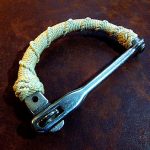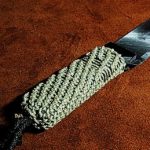French Hitching
How to Tie French Hitching or French Whipping
French Hitching is a very simple but decorative way of covering an object. French Whipping can also be used to whip the end of a rope to prevent it from fraying or unravelling. I have used this in the past when I wanted to put a simple and fast decorative rope-work on say a handle of some sorts.
Moku Hitching
When French Hitching you use on piece of cord and tie a hitch around the object constantly in the same direction. With Moku Hitching it is basically the same process, but two cords are used and the hitching of each cord is tied in the opposite direction. Here is a link on How to Tie Moku Hitching.
French Whipping ABoK 3450
Here is what Ashley’s Book of Knots says about French Whipping: ….. is merely a series of Half Hitches. Start with a Running Eye and finish with the end tucked back under the last few hitches. The ridge of the hitches should follow the lay of the tope.
Starting and Finishing French Hitching
Ashley’s mentions above the way of starting and finishing French Hitching. Personally, I like to complete some of my French Hitching by adding a Turks Head at either end. The Turks Head adds a little more decoration, and is also a great way of hiding ragged ends. When I see a Turks Head knot, I will always ask myself “what horrors is it covering”.
How to Tie French Hitching Video
How to Tie French Hitching or French Whipping Video Tutorial. In this video, I demonstrate how to tie French Hitching to cover an object. I can also see, that I really need to up-date this video. So keep an eye out, there will be a newer version shortly.
What is French Whipping Used For?
French Hitching if often used on the ends for ropes, similar to Common Whipping, to prevent the rope from unravelling or fraying. It is also used to add a decorative pattern over and object.
Des Pawson’s Book on Knot Craft
If you’re on the lookout for an outstanding guide to decorative knotting, Des Pawson’s “Book on Knot Craft” is a top-notch recommendation. Featuring a diverse collection of 60 projects and 20 imaginative rope mat designs, this book caters to knot enthusiasts at all levels of proficiency. What sets it apart is its user-friendly approach, offering clear and detailed instructions on the specific length of cordage or rope required for each project. Whether you’re a beginner or an experienced knot crafter, this book ensures an engaging and enjoyable exploration into the intricacies of knot crafting. With Pawson’s expertise and a wealth of valuable content, it’s an essential addition to the library of anyone passionate about the art of knotting.
| | Ashley Book of Knot (ABoK) This really is the bible of all knots, consisting of over 600 pages and over 3000 diagrams Rating: | ||
| | Knot Craft and Rope Mats: 60 Ropework Projects Including 20 Mat Designs by Des Pawson Rating: | ||
| | The Marlinspike Sailor by Harvey Garret Smith If you are starting to build a collection of knotting books, then this is a great one to have in your library. Rating: | ||
| | A Practical Guide to Tying Knots by Geoffrey Budworth This book contains 75 bends, hitches, knots, bindings, loops, mats, plaits, rings and slings. Rating: |








Pingback:How to Tie the Matthew Walker Knot
Pingback:Whipping the End of a Rope (Colour)